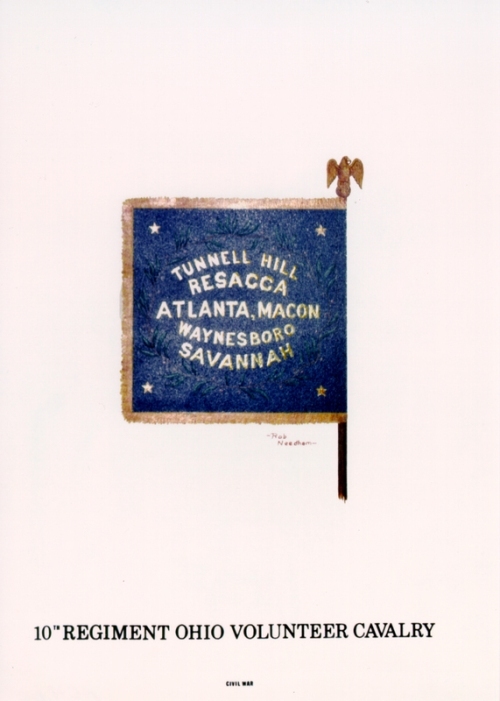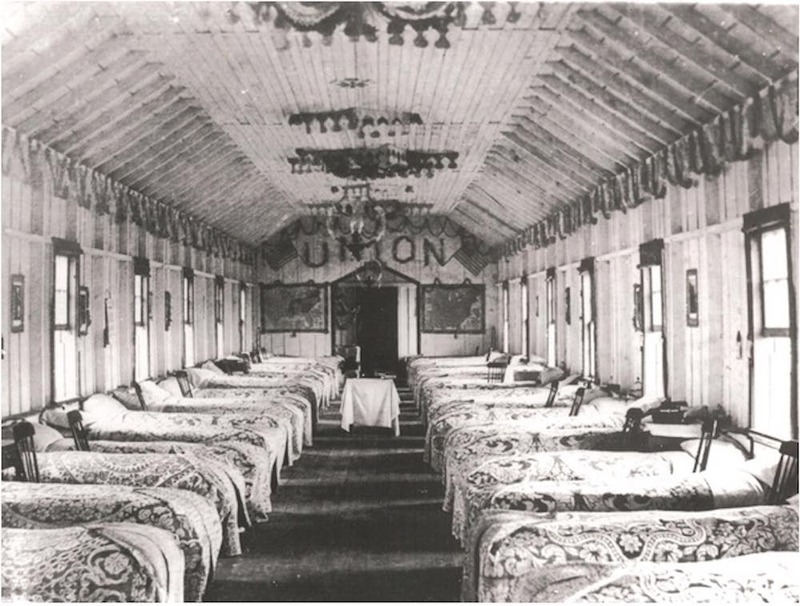Camp Cleveland

On November 24, 1862, in what was then University Heights and now is Tremont, Governor David Tod ascended a large hill to be greeted by a 15-gun salute from the 20th Ohio Independent Battery. The governor was here to inspect Camp Cleveland—the largest of Cleveland’s six Civil War training camps and the only one in operation after 1861. Although the 20th had only been at Camp Cleveland for about a month, other regiments had occupied the camp as early as August, 1862. In fact, just three weeks before Governor Tod arrived, 8,100 men were stationed there. By the war’s end more than 15,000 soldiers (five percent of the troops raised in Ohio) had trained at Camp Cleveland.
Other Civil War training camps—Taylor (E. 30th and Woodlawn), Wade (occupying a part of what became Camp Cleveland), Brown (Euclid and East 46th), Wood (E. 37th and Woodland) and Tod (also along Woodland)—were launched at the beginning of the war, but all closed in late 1861. There were no camps in the area until Camp Cleveland opened in July 1862—once the reality of a long, bloody war became apparent.
Camp Cleveland was distinctive in many ways: Situated on 35.5 acres owned by real estate developer Silas Stone, Camp Cleveland enjoyed an elevated but exceptionally flat location, ample clean water, and primarily wooden structures rather than tents. It was close to the river and easily accessible to Cleveland’s west side, downtown and (by travelling through the Flats) the east side. Recruitment for the camp was done at a variety of downtown locations as well as in a barn on Auburn Avenue, about a mile south of the Camp.
Camp Cleveland’s borders comprised Hershel (now West 5th Street) on the east, University Street (now West 7th Street) on the west, Railway Avenue (now University Road) on the north, and South Street (now Marquardt Avenue) on the south. A small salient west of University Street (West 7th) and south of Franklin Street (now Jefferson Avenue) contained buildings for the camp staff: two for the commandant, three for quartermaster’s stores and a stable.
Walking around Camp Cleveland on the day of his visit, Governor Tod would have seen scores of buildings used for privates’ quarters. Behind these were officers’ barracks. On the eastern side of the camp were six buildings occupied by artillery troops. An arsenal was located in the center of the camp. Other structures included a guardhouse and a chapel. Natural springs and a well supplied the camp’s drinking water.
Barracks were made of unfinished pine wood and were 20 feet wide and 60 feet long, held 32 men and had a stove for heating. Soldiers slept on un-planed wooden bunks, using straw for mattresses and knapsacks for pillows. Meals were brought into the barracks and dished out to each man. A typical evening meal consisted of meat, vegetables, soup and bread. Coffee was drawn by dipping cups into a large kettle. Milk, butter and sugar were rarely available. Troops had to stand while eating due to a lack of barracks furniture. Shelves were used as tables.
In their leisure time, soldiers received visitors, wrote letters, attended worship services, held picnics, listened to music and ventured into Cleveland to frequent the city’s many taverns, see the sights or have photographs taken. Bands often came to Camp Cleveland to entertain the troops. Street vendors sold souvenirs and photographers set up shop to take pictures of soldiers in their new uniforms. “Base-ball” games were played on the parade grounds.
To serve the camp, the U.S. General Hospital Cleveland (USGHC) was built at what is now the southeast corner of West 5th Street and Jefferson Avenue. The 3.76-acre complex consisted of a main building (300 feet long, oriented north to south along Herschel Street), a half-dozen wards and myriad detached buildings. At the crest of the ridge overlooking the Flats was Ward I: the Pest-House (contagious disease ward). Close by was the morgue. Other structures included an office and forage house; a stable and stable sheds; and a mess house. A hospital reading room was open from 8:30 AM to tattoo. On the wall was a sign declaring . . .
• No card playing, loud talk or disorderly conduct.
• Smoking is permitted but spitting on the floor is forbidden.
• No whittling on tables or benches.
• No papers or books may be taken out of the room without special permission of the chaplain.
Ill and wounded soldiers headed for the Camp Cleveland hospital would generally arrive by train at Cleveland’s Union Depot, where they would be transported by various means—private citizens, omnibus hacks (carriages), volunteers from the Ladies’ Aid Society—to the hospital. Throughout the war, more than 3,000 sick and injured soldiers were treated at USGHC. Most deaths at the hospital were due to disease—primarily malaria, typhoid, diarrhea and measles. One man died of liquor poisoning and another slit his throat rather than undergo an amputation without anesthesia. Only six died from wounds received in battle.
As the war came to an end, more than 11,000 troops made their final stop at Camp Cleveland to be paid and discharged (“mustered out”) before returning home.
In July, 1865, Camp Cleveland was closed and disassembled, with the property returned to its lessor, Silas Stone, who sold it to a group of investors. The land subsequently was surveyed and divided into building lots. Many of the barracks were sold to private individuals and, although it has never been researched, several likely ended up as tool sheds or chicken coops on properties scattered around the city. Camp equipment and government property were sold at public auction. The hospital closed in late summer, with remaining patients sent to Camp Dennison General Hospital near Cincinnati. By October, the Camp Cleveland barracks, hospital and prison had been razed.
In 1896 (Cleveland’s centennial) Pelton park was renamed Lincoln Park to honor both the president and the memory of Camp Cleveland. In October, 2003, the State of Ohio placed a historical marker near the site of the original Camp Cleveland. A dedication program was held, with participation by the 19th OVA Reenactment Battery and the Cleveland Grays Color Guard.
Images






